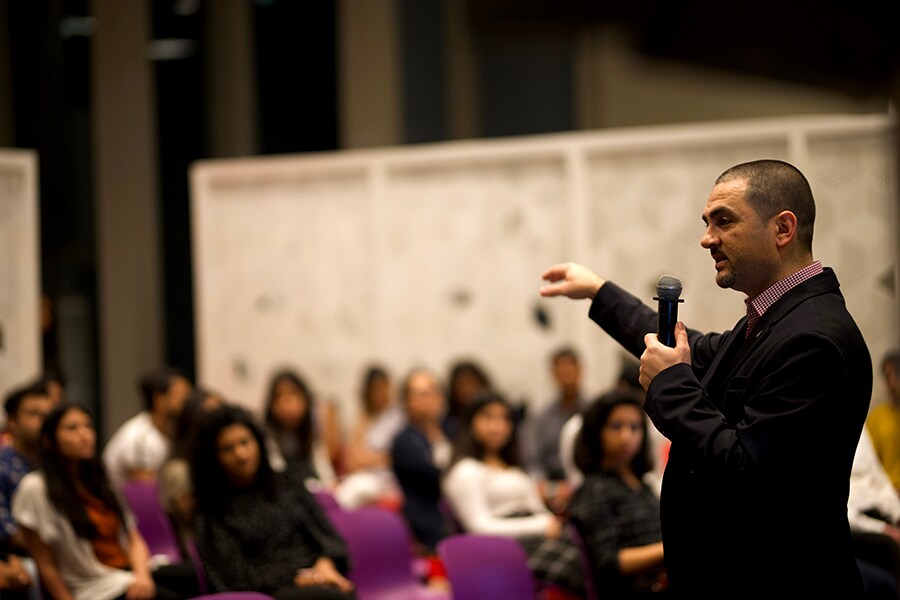
'With AI, ML, fashion shifts from ecommerce to 'a-commerce'': Abdullah Abo Milhim
In the age of extreme personalisation, fashion and retail businesses must use data to build automated or augmented commerce models, says Milhim of Istituto Marangoni London
 Abdullah Abo Milhim
Abdullah Abo Milhim How does big data and artificial intelligence impact the business models of fashion labels? What will the future of the industry look like, since we’re already seeing fashion houses scale down on jobs that can be automated, such as fashion buying? Abdullah Abo Milhim, programme leader, MA Fashion Business, Istituto Marangoni London, visited Mumbai recently, and spoke with Forbes India about the tectonic shift in fashion and retail, thanks to technology.
Q. How can big data and artificial intelligence be integrated within business models in the fashion world?
Artificial intelligence and big data are not new. But what we are now seeing is that retail, in general, has only now started asking big questions about how we can use them. Businesses have started feeling that disruption is coming from consumers. They are telling companies what they want, using technology—what we call personalisation.
Previously, technology was one of the aspects that could change the business model; now, technology drives the entire business model. While some brands have started making the shift, it can take years. The problem is that one needs to create a culture around digital, where people accept technology, have the skills and mindset around that. We are seeing a number of brands now collaborating with technology companies to do these things.
Q. At a time like this, when artificial intelligence and machine learning can create automated designs, how relevant is the artist?
A.This continues to be a grey area. In the retail sector, people are raising questions about whether jobs such as fashion buying and artists will be relevant in the near future. There is so much fear and panic that departments like fashion buying are now closing at universities; department stores are restructuring themselves to need fewer fashion buyers.
However, I subscribe to the other view, that technology is just another edge; it is not something that will replace the DNA of fashion. I think the companies that will fail the fashion industry are ones who get driven so much with technology that they forget about this DNA.
We can shift from using traditional methods to using technology. But we do need people to expand their knowledge and skills in data analytics and understand how they are relevant for that industry. Instead of seeing these technologies as something that will destroy our jobs, we need to be much more open minded and look at it as something that will create future jobs.
Q. What will the impact of big data be on design, demand and resale in the fashion industry?
A.Big data is stored, analysed and makes predictions simultaneously. It has the ability to do bring all the aspects of fashion together in real time, collaboratively. The conversation is no longer about moving from one channel to another. This means that instead of design, resale and demand being three different parts, it is all part of one large network now. So data can be prescriptive, descriptive, but also can be predictive, and the future is about predictive.
Q. How have these technologies helped with new value chain strategies?
A. Historically, in the value chain, one of the supporting activities is data or digital, but we feel that this value chain structure needs to be a little reconfigured. So data, instead of being one of the resources that the company has, is becoming one of the drivers of the whole supply chain. Data is branching out from what it used to be, dividing the value chain into three parts: Finding the data, storing the data and analysing the data. Maybe we're going to have another edge, the ability of the data to have cognitive skills, which enable it to take decisions based on analysis.
Q. Some global trends in the fashion industry…
A. Big data is now showing us new ways of trend forecasting. In fashion, trends used to be the most valuable, and we wanted to know them in advance. Now, however, trends are no longer fundamental issues, because each consumer is different. The focus is on becoming more personalized, more individualistic. Millennials want to see a lot of personalisation in everything they buy; they want to see things that represent them. However, Generation Z is the opposite when it comes to spending. They buy selectively and strategically and are big savers. These are very sophisticated consumers, with access to a lot more data. This means they are more aware of what exists and what does not.
For instance, some trends we are seeing include that consumers want their products delivered quickly, which means the supply chain is becoming shorter. Since 2018, we have seen a shift from e-commerce to a-commerce—automated or augmented commerce—which means consumers can use technologies to tell the business about the kind of product they want.















